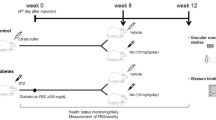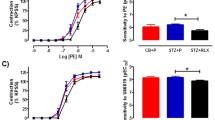Abstract
Hydrogen sulfide (H2S) is an endogenous gas which has potent relaxant effect in vascular and nonvascular smooth muscles. In the present study, we have investigated how streptozotocin (STZ)-induced diabetes affected the relaxant effect of H2S in rat isolated thoracic aorta and mesenteric and pulmonary arteries. Diabetes was induced by IV injection of STZ (35 mg/kg). Insulin treatment was applied by using insulin implants. At the end of 4 and 12 weeks, the thoracic aorta and mesenteric and pulmonary arteries were isolated, and the relaxation responses to sodium hydrogen sulfide (NaHS), diazoxide, and acetylcholine were evaluated. The mRNA and protein levels of H2S-synthesizing enzymes were also examined by RT-PCR and Western Blot. The relaxation response to NaHS in the arteries isolated from both 4 and 12 week-diabetic rats was increased when compared with that obtained from the control group. Glibenclamide inhibited the relaxation response to NaHS in the arteries isolated from either diabetic or non-diabetic group of rats. Concurrent treatment of insulin to STZ-injected rats prevented the potentiation of the relaxant effect of NaHS in the arteries. However, acetylcholine and diazoxide-induced relaxation responses were not altered in diabetic group of rats. The mRNA and protein levels of H2S-synthesizing enzymes were also not altered in diabetic rats. STZ-induced experimental diabetes in rats resulted in the potentiation of the relaxation response to H2S in vascular tissues. The potentiated relaxation to H2S in diabetic arteries may play a role in vascular complications frequently seen in severe diabetes.







Similar content being viewed by others
References
Abe K, Kimura H (1996) The possible role of hydrogen sulfide as an endogenous neuromodulator. J Neurosci 16:1066–1071
Ali MY, Whiteman M, Low CM, Moore PK (2007) Hydrogen sulphide reduces insulin secretion from HIT-T15 cells by a KATP channel-dependent pathway. J Endocrinol 195:105–112
Bao L, Vlcek C, Paces V, Kraus JP (1998) Identification and tissue distribution of human cystathionine beta-synthase mRNA isoforms. Arch Biochem Biophys 350:95–103
Brancaleone V, Roviezzo F, Vellecco V, De Gruttola L, Bucci M, Cirino G (2008) Biosynthesis of H2S is impaired in non-obese diabetic (NOD) mice. Br J Pharmacol 155:673–680
Chunyu Z, Junbao D, Dingfang B, Hui Y, Xiuying T, Chaoshu T (2003) The regulatory effect of hydrogen sulfide on hypoxic pulmonary hypertension in rats. Biochem Biophys Res Commun 302:810–816
De Vriese AS, Verbeuren TJ, Van de Voorde J, Lameire NH, Vanhoutte PM (2000) Endothelial dysfunction in diabetes. Br J Pharmacol 130:963–974
Dombkowski RA, Russell MJ, Olson KR (2004) Hydrogen sulfide as an endogenous regulator of vascular smooth muscle tone in trout. Am J Physiol Regul Integr Comp Physiol 286:R678–R685
Fujita A, Kurachi Y (2000) Molecular aspects of ATP-sensitive K + channels in the cardiovascular system and K + channel openers. Pharmacol Ther 85:39–53
Hayden LJ, Franklin KJ, Roth SH, Moore GJ (1989) Inhibition of oxytocin-induced but not angiotensin-induced rat uterine contractions following exposure to sodium sulfide. Life Sci 45:2557–2560
Hosoki R, Matsuki N, Kimura H (1997) The possible role of hydrogen sulfide as an endogenous smooth muscle relaxant in synergy with nitric oxide. Biochem Biophys Res Commun 237:527–531
Jandeleit-Dahm K, Hannan KM, Farrelly CA, Allen TJ, Rumble JR, Gilbert RE, Cooper ME, Little PJ (2000) Diabetes-induced vascular hypertrophy is accompanied by activation of Na(+)-H(+) exchange and prevented by Na(+)-H(+) exchange inhibition. Circ Res 87:1133–1140
Kimura H (2002) Hydrogen sulfide as a neuromodulator. Mol Neurobiol 26:13–19
Kiss L, Deitch EA, Szabo C (2008) Hydrogen sulfide decreases adenosine triphosphate levels in aortic rings and leads to vasorelaxation via metabolic inhibition. Life Sci 83:589–594
Kocaefe C, Balci D, Hayta BB, Can A (2010) Reprogramming of human umbilical cord stromal mesenchymal stem cells for myogenic differentiation and muscle repair. Stem Cell Rev 6:512–522
Lee SW, Cheng Y, Moore PK, Bian JS (2007) Hydrogen sulphide regulates intracellular pH in vascular smooth muscle cells. Biochem Biophys Res Commun 358:1142–1147
Mok YY, Atan MS, Yoke Ping C, Zhong Jing W, Bhatia M, Moochhala S, Moore PK (2004) Role of hydrogen sulphide in haemorrhagic shock in the rat: protective effect of inhibitors of hydrogen sulphide biosynthesis. Br J Pharmacol 143:881–889
Richardson CJ, Magee EA, Cummings JH (2000) A new method for the determination of sulphide in gastrointestinal contents and whole blood by microdistillation and ion chromatography. Clin Chim Acta 293:115–125
Sidhu R, Singh M, Samir G, Carson RJ (2001) L-cysteine and sodium hydrosulphide inhibit spontaneous contractility in isolated pregnant rat uterine strips in vitro. Pharmacol Toxicol 88:198–203
Teague B, Asiedu S, Moore PK (2002) The smooth muscle relaxant effect of hydrogen sulphide in vitro: evidence for a physiological role to control intestinal contractility. Br J Pharmacol 137:139–145
Wang R (2002) Two’s company, three’s a crowd: can H2S be the third endogenous gaseous transmitter? FASEB J 16:1792–1798
Warenycia MW, Reiffenstein RJ, Goodwin LR, Dieken FP (1989) Brain sulfide levels in anaesthesia: a comparison with hydrogen sulfide intoxication. Toxicol Lett 47:221–224
Weintraub NL (2003) Impaired hypoxic coronary vasodilation and ATP-sensitive potassium channel function: a manifestation of diabetic microangiopathy in humans? Circ Res 92:127–129
Williams B, Howard RL (1994) Glucose-induced changes in Na+/H + antiport activity and gene expression in cultured vascular smooth muscle cells. Role of protein kinase C. J Clin Invest 93:2623–2631
Yan H, Du J, Tang C (2004) The possible role of hydrogen sulfide on the pathogenesis of spontaneous hypertension in rats. Biochem Biophys Res Commun 313:22–27
Yusuf M, Kwong Huat BT, Hsu A, Whiteman M, Bhatia M, Moore PK (2005) Streptozotocin-induced diabetes in the rat is associated with enhanced tissue hydrogen sulfide biosynthesis. Biochem Biophys Res Commun 333:1146–1152
Yuzbasioglu A, Onbasilar I, Kocaefe C, Ozguc M (2010) Assessment of housekeeping genes for use in normalization of real time PCR in skeletal muscle with chronic degenerative changes. Exp Mol Pathol 88:326–329
Zhao W, Wang R (2002) H(2)S-induced vasorelaxation and underlying cellular and molecular mechanisms. Am J Physiol Heart Circ Physiol 283:H474–480
Zhao W, Zhang J, Lu Y, Wang R (2001) The vasorelaxant effect of H(2)S as a novel endogenous gaseous K(ATP) channel opener. EMBO J 20:6008–6016
Acknowledgments
This study is supported by Hacettepe University Research Foundation.
Some of this work was presented as a poster in the “Federation of the European Pharmacological Societies (EPHAR) 2008 Congress”, 13–17 July 2008, Manchester, UK.
Conflict of interest
None
Author information
Authors and Affiliations
Corresponding author
Rights and permissions
About this article
Cite this article
Denizalti, M., Bozkurt, T.E., Akpulat, U. et al. The vasorelaxant effect of hydrogen sulfide is enhanced in streptozotocin-induced diabetic rats. Naunyn-Schmiedeberg's Arch Pharmacol 383, 509–517 (2011). https://doi.org/10.1007/s00210-011-0601-6
Received:
Accepted:
Published:
Issue Date:
DOI: https://doi.org/10.1007/s00210-011-0601-6




